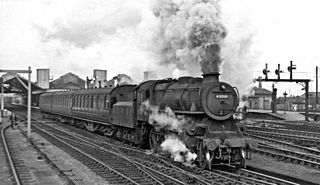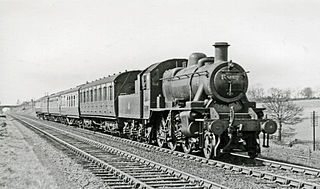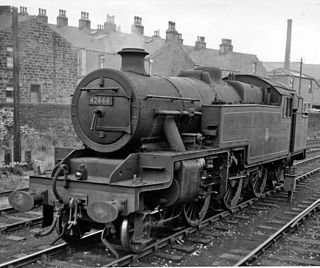| LMS Class 2P 4-4-0 | |||||||||||||||||||||||||||||||||||||||||||||||||
|---|---|---|---|---|---|---|---|---|---|---|---|---|---|---|---|---|---|---|---|---|---|---|---|---|---|---|---|---|---|---|---|---|---|---|---|---|---|---|---|---|---|---|---|---|---|---|---|---|---|
 40688 at Kilmarnock | |||||||||||||||||||||||||||||||||||||||||||||||||
| |||||||||||||||||||||||||||||||||||||||||||||||||
| |||||||||||||||||||||||||||||||||||||||||||||||||
| |||||||||||||||||||||||||||||||||||||||||||||||||
| |||||||||||||||||||||||||||||||||||||||||||||||||
The London, Midland and Scottish Railway Class 2P 4-4-0 was a class of steam locomotive designed for light passenger work.
| LMS Class 2P 4-4-0 | |||||||||||||||||||||||||||||||||||||||||||||||||
|---|---|---|---|---|---|---|---|---|---|---|---|---|---|---|---|---|---|---|---|---|---|---|---|---|---|---|---|---|---|---|---|---|---|---|---|---|---|---|---|---|---|---|---|---|---|---|---|---|---|
 40688 at Kilmarnock | |||||||||||||||||||||||||||||||||||||||||||||||||
| |||||||||||||||||||||||||||||||||||||||||||||||||
| |||||||||||||||||||||||||||||||||||||||||||||||||
| |||||||||||||||||||||||||||||||||||||||||||||||||
| |||||||||||||||||||||||||||||||||||||||||||||||||
The London, Midland and Scottish Railway Class 2P 4-4-0 was a class of steam locomotive designed for light passenger work.
The class was introduced in 1928 and was a post-grouping development of the Midland Railway 483 Class with modified dimensions and reduced boiler mountings.
The numbering continued from where the Midland engines left off at 563 and eventually reached 700. 138 were built, though numbering is slightly complicated by renumberings and transfers.
| Numbers | Lot No. | Date built | Built at | Notes | ||
|---|---|---|---|---|---|---|
| Original | 2nd | BR | ||||
| 563–571 | — | 40563–40571 | 49 | 1928 | Derby | |
| 572 | 601 | 40601 | 49 | 1928 | Derby | Experimentally fitted with Owen's double port exhaust valves from new and renumbered immediately after entering service |
| 572 | — | 40572 | 49 | 1928 | Derby | Replacement for first No. 572 |
| 573–574 | — | 40573–40574 | 49 | 1928 | Derby | |
| 575–576 | 633–634 | 40633–40634 | 49 | 1928 | Derby | Transferred to S&DJR Nos 44–45 in 1928, retaken into LMS stock 1930 |
| 575–576 | — | 40575–40576 | 67 | 1929 | Derby | Replacement for engines transferred to S&DJR |
| 577–579 | — | 40577–40579 | 49 | 1928 | Derby | |
| 580 | 635 | 40635 | 49 | 1928 | Derby | Transferred to S&DJR No. 46 in 1928, retaken into LMS stock 1930. |
| 580 | — | 40580 | 67 | 1929 | Derby | Replacement for engine transferred to S&DJR |
| 581–600 | — | 40581–40600 | 49 | 1928 | Derby | |
| 602–612 | — | 40602–40612 | 49 | 1928 | Derby | |
| 613–628 | — | 40613–40627 | 67 | 1929 | Derby | |
| 629–632 | — | 40629–40632 | 67 | 1930 | Derby | |
| 636–660 | — | 40636–40660 | 76 | 1931 | Crewe | |
| 661–665 | — | 40661–40665 | 77 | 1931 | Derby | |
| 666–685 | — | 40666–40685 | 77 | 1932 | Derby | |
| 686–700 | — | 40686–40700 | 85 | 1932 | Crewe | |
Numbers 633 and 653 were fitted with Dabeg feedwater heater in 1933. [1] Numbers 591 and 639 were withdrawn in 1934 after being heavily damaged in an accident at Port Eglinton Junction near Cumberland Street Station, Glasgow on 6 September of the same year. After nationalisation in 1948, British Railways added 40000 to the numbers of the remaining 136 engines. Further withdrawals came between 1954 and 1962. All were scrapped.


| Year | Number in service at start of year | Number withdrawn | Locomotive numbers |
|---|---|---|---|
| 1934 | 138 | 2 | 591, 639. |
| 1954 | 136 | 1 | 40662. |
| 1957 | 135 | 1 | 40676. |
| 1959 | 134 | 43 | 40565/67–68/73/76/82/87/89–90/94/98–601/05–08/10–11/16–17/33/36/44/49/53–56/58/60/66–67/73–75/77/79–80/88/93/99. |
| 1960 | 91 | 10 | 40581/83–84/88, 40630–31/52/71/90/98. |
| 1961 | 81 | 66 | 40566/69–72/74–75/77–80/85–86/92–93/95–97, 40602–04/09/12–15/18–29/32/35/37/40–43/45/47–48/50–51/59/61/63/68–69/78/82–87/89/91–92/95. |
| 1962 | 15 | 15 | 40563–64, 40634/38/46/57/64–65/70/72/81/94/96–97, 40700. |
Hornby produce a 00 gauge model based on the old Dapol (formerly Airfix) tooling which is reasonably accurate. [2] Graham Farish produced an N gauge model of the 4P 4-4-0 Compound when they were in Poole, Dorset, and the chassis for this could be modified to represent the 2P. Union Mills on the Isle of Man make a 2P in N gauge.
The London, Midland and Scottish Railway had the largest stock of steam locomotives of any of the 'Big Four' Grouping, i.e. pre-Nationalisation railway companies in the UK. Despite early troubles arising from factions within the new company, the LMS went on to build some very successful designs; many lasted until the end of steam traction on British Railways in 1968. For an explanation of numbering and classification, see British Rail locomotive and multiple unit numbering and classification.

The London, Midland and Scottish Railway (LMS) Jubilee Class is a class of steam locomotive designed for main line passenger work. 191 locomotives were built between 1934 and 1936. They were built concurrently with the similar looking LMS Stanier Class 5 4-6-0. They were nicknamed Red Staniers and Jubs.

The British Rail Class 11 was applied to a batch of diesel shunting locomotives built from April 1945 to December 1952, based on a similar earlier batch built by the London, Midland and Scottish Railway (LMS) between 1934 and 1936.

The British Railways Class D3/7 is a class of 0-6-0 diesel electric shunting locomotives built as LMS Nos. 7080–7119. The class were built from May 1939 through to July 1942 by the London, Midland and Scottish Railway at their Derby Works using a diesel electric transmission supplied by English Electric.

Under the Whyte notation for the classification of steam locomotives, a 2-6-4 locomotive has two leading wheels, six coupled driving wheels and four trailing wheels.

The London, Midland and Scottish Railway (LMS) Fairburn Tank 2-6-4T is a class of steam locomotive. They were designed by Charles E. Fairburn for the LMS. 277 of these locomotives were built between 1945 and 1951, numbered in the range 42050–42186, (4)2187–(4)2299, (4)2673–(4)2699.
The London, Midland and Scottish Railway (LMS) pioneered the use of diesel shunting locomotives in Great Britain. The variety of experimental and production diesel shunters produced by the LMS is summarised below.

The Patriot Class was a class of 52 express passenger steam locomotives built for the London Midland and Scottish Railway. The first locomotive of the class was built in 1930 and the last in 1934. The class was based on the chassis of the Royal Scot combined with the boiler from Large Claughtons earning them the nickname Baby Scots. A total of 18 were rebuilt to create the LMS Rebuilt Patriot Class between 1946 and 1948; thereafter those not subjected to rebuilding were often referred to as the Unrebuilt Patriot Class. These remaining 34 unrebuilt engines were withdrawn between 1960 and 1962.

The London, Midland and Scottish Railway (LMS) Hughes Crab or Horwich Mogul is a class of mixed-traffic 2-6-0 steam locomotive built between 1926 and 1932. They are noted for their appearance with large steeply-angled cylinders to accommodate a restricted loading gauge.

The LMS Ivatt Class 4 2-6-0 is a class of steam locomotive primarily designed for medium freight work but also widely used on secondary passenger services. The London, Midland and Scottish Railway (LMS) ordered 162 of this type between 1947 and 1952, but only three were built by the LMS before nationalisation in 1948. Designed by George Ivatt, they were classified 4F by the LMS and 4MT by British Railways (BR).

The London, Midland and Scottish Railway (LMS) Stanier Class 2 0-4-4T was a class of 10 light passenger locomotives built in 1932. Ostensibly designed under new Chief Mechanical Engineer (CME) William Stanier, they were in fact the last new design of the Midland Railway's school of engineering.

The London, Midland and Scottish Railway (LMS) Ivatt Class 2 2-6-0 is a class of steam locomotive designed for light mixed traffic.

The London, Midland and Scottish Railway (LMS) Ivatt Class 2 2-6-2T is a class of light 'mixed-traffic' steam locomotive introduced in 1946.

Sir William Stanier's London, Midland and Scottish Railway (LMS) Class 4P 2-Cylinder 2-6-4T was a class of 206 steam locomotive built between 1935 and 1943. They were based on his LMS 3-Cylinder 2-6-4T.

The London, Midland and Scottish Railway (LMS) Fowler 3F0-6-0T is a class of steam locomotives, often known as Jinty. They represent the ultimate development of the Midland Railway's six-coupled tank engines. They could reach speeds of up to 60 mph (97 km/h).

The London Midland and Scottish Railway (LMS) Fowler Class 4F is a class of 0-6-0 steam locomotive designed for medium freight work. They represent the ultimate development of Midland Railway's six coupled tender engines. Many trainspotters knew them as "Duck Sixes", a nickname derived from their wheel arrangement.

The Midland Railway (MR) 3835 Class is a class of 0-6-0 steam locomotives designed for freight work. The first two were introduced in 1911 by Henry Fowler. After the grouping in 1923, the designs were slightly modified and continued to be built up to 1941 by the LMS as the LMS Fowler Class 4F.

W. G. Bagnall was a locomotive manufacturer from Stafford, England which was founded in 1875 and operated until it was taken over in 1962 by English Electric.
The LMS Northern Counties Committee (NCC) Class Y was a class of 0-6-0T steam locomotives formed when two LMS Fowler Class 3F engines were regauged from 4 ft 8+1⁄2 instandard gauge to the 5 ft 3 in Irish broad gauge in 1944 becoming NCC Nos.18 and 19.

The London Midland and Scottish Railway (LMS), Rebuilt Patriot Class was a class of 4-6-0 steam locomotives. They were rebuilt from LMS Patriot Class locomotives over the period 1946–1949. By the end of 1947, the LMS had rebuilt seven engines, these being 5514/21/26/29–31/40. After nationalisation, a further eleven locomotives were rebuilt. Rebuilt locomotives retained their numbers.